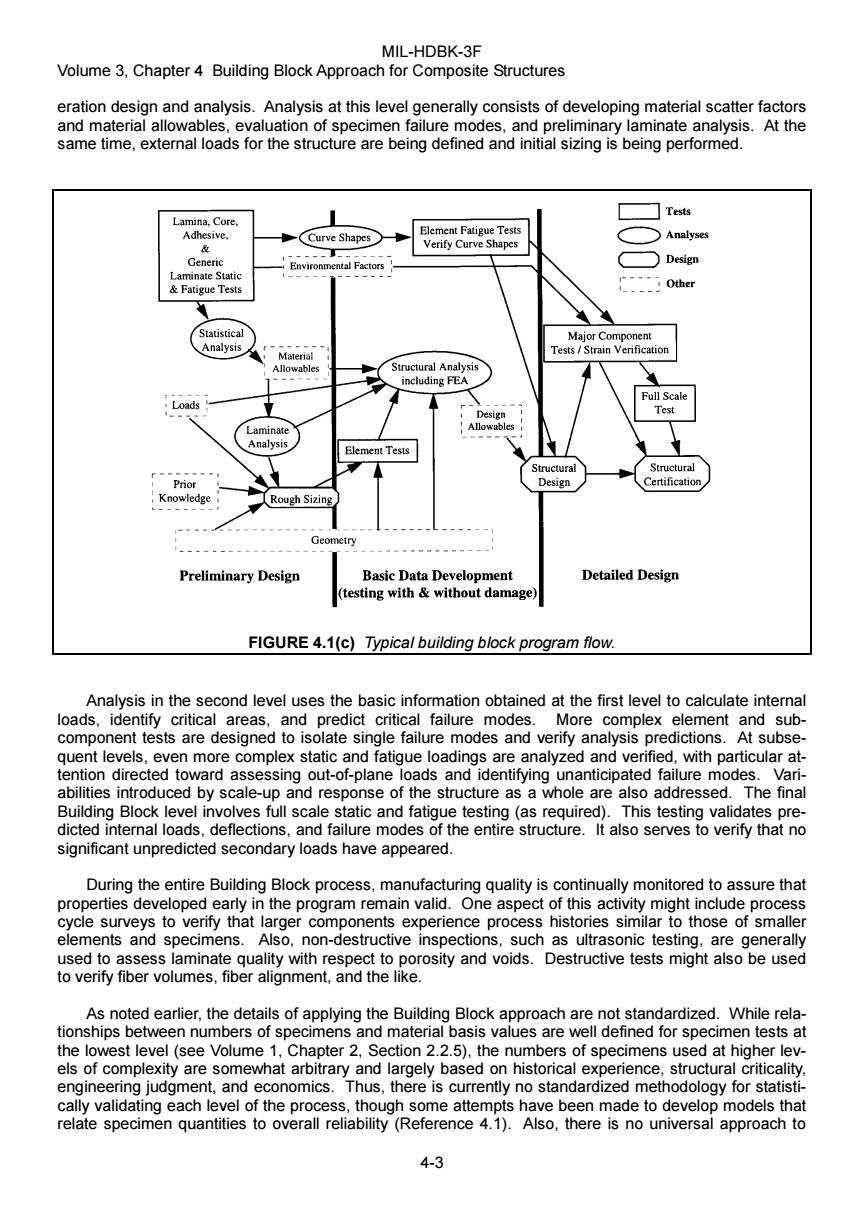正在加载图片...

MIL-HDBK-3F Volume 3,Chapter 4 Building Block Approach for Composite Structures eration design and analysis.Analysis at this level generally consists of developing material scatter factors and material allowables,evaluation of specimen failure modes,and preliminary laminate analysis.At the same time,external loads for the structure are being defined and initial sizing is being performed. Tests Lamina,Core. Adhesive, Element Fatigue Tests Curve Shapes Analyses & Verify Curve Shapes Generic Environmental Factors Design Laminate Static Fatigue Tests ----Other Statistical Major Component Analysis Material Tests/Strain Verification Allowables Structural Analysis including FEA Full Scale .Loads Design Test Laminate Allowables Analysis Element Tests Structural Structural Prior Design Certification Knowledge 、Rough Sizing Geometry Preliminary Design Basic Data Development Detailed Design (testing with without damage) FIGURE 4.1(c)Typical building block program flow. Analysis in the second level uses the basic information obtained at the first level to calculate internal loads,identify critical areas,and predict critical failure modes.More complex element and sub- component tests are designed to isolate single failure modes and verify analysis predictions.At subse- quent levels,even more complex static and fatigue loadings are analyzed and verified,with particular at- tention directed toward assessing out-of-plane loads and identifying unanticipated failure modes.Vari- abilities introduced by scale-up and response of the structure as a whole are also addressed.The final Building Block level involves full scale static and fatigue testing (as required).This testing validates pre- dicted internal loads.deflections.and failure modes of the entire structure.It also serves to verify that no significant unpredicted secondary loads have appeared. During the entire Building Block process,manufacturing quality is continually monitored to assure that properties developed early in the program remain valid.One aspect of this activity might include process cycle surveys to verify that larger components experience process histories similar to those of smaller elements and specimens.Also,non-destructive inspections,such as ultrasonic testing,are generally used to assess laminate quality with respect to porosity and voids.Destructive tests might also be used to verify fiber volumes,fiber alignment,and the like. As noted earlier,the details of applying the Building Block approach are not standardized.While rela- tionships between numbers of specimens and material basis values are well defined for specimen tests at the lowest level (see Volume 1,Chapter 2,Section 2.2.5),the numbers of specimens used at higher lev- els of complexity are somewhat arbitrary and largely based on historical experience,structural criticality, engineering judgment,and economics.Thus,there is currently no standardized methodology for statisti- cally validating each level of the process,though some attempts have been made to develop models that relate specimen quantities to overall reliability(Reference 4.1).Also,there is no universal approach to 4-3MIL-HDBK-3F Volume 3, Chapter 4 Building Block Approach for Composite Structures 4-3 eration design and analysis. Analysis at this level generally consists of developing material scatter factors and material allowables, evaluation of specimen failure modes, and preliminary laminate analysis. At the same time, external loads for the structure are being defined and initial sizing is being performed. FIGURE 4.1(c) Typical building block program flow. Analysis in the second level uses the basic information obtained at the first level to calculate internal loads, identify critical areas, and predict critical failure modes. More complex element and subcomponent tests are designed to isolate single failure modes and verify analysis predictions. At subsequent levels, even more complex static and fatigue loadings are analyzed and verified, with particular attention directed toward assessing out-of-plane loads and identifying unanticipated failure modes. Variabilities introduced by scale-up and response of the structure as a whole are also addressed. The final Building Block level involves full scale static and fatigue testing (as required). This testing validates predicted internal loads, deflections, and failure modes of the entire structure. It also serves to verify that no significant unpredicted secondary loads have appeared. During the entire Building Block process, manufacturing quality is continually monitored to assure that properties developed early in the program remain valid. One aspect of this activity might include process cycle surveys to verify that larger components experience process histories similar to those of smaller elements and specimens. Also, non-destructive inspections, such as ultrasonic testing, are generally used to assess laminate quality with respect to porosity and voids. Destructive tests might also be used to verify fiber volumes, fiber alignment, and the like. As noted earlier, the details of applying the Building Block approach are not standardized. While relationships between numbers of specimens and material basis values are well defined for specimen tests at the lowest level (see Volume 1, Chapter 2, Section 2.2.5), the numbers of specimens used at higher levels of complexity are somewhat arbitrary and largely based on historical experience, structural criticality, engineering judgment, and economics. Thus, there is currently no standardized methodology for statistically validating each level of the process, though some attempts have been made to develop models that relate specimen quantities to overall reliability (Reference 4.1). Also, there is no universal approach to